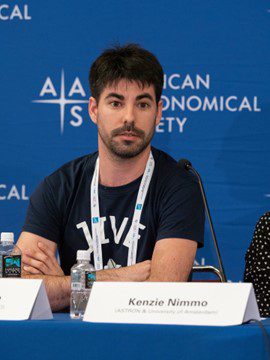The Universe is a place that still awaits us with many surprises and phenomena to discover. Known as Fast Radio Bursts (FRBs), they are flashes of light observed at radio frequencies that only last for a thousandth of a second and have been known for only 15 years. It is impossible to predict when they will happen, but what we do know is that it is a very common phenomenon in the Universe. Around a thousand FRBs could be detected every day, if we were looking at the whole sky continuously. Of these, the vast majority appear to occur only once. A flash of light in a thousandth of a second and absolutely nothing the rest of the time. What we do know is that they occur at cosmological distances, in galaxies very far from ours,
Although the first FRB was discovered in 2007, it was not until ten years later that it was possible to locate with sufficient precision in the sky where one of these bursts came from. For this we have the help of the EVN, which is how the European VLBI (Very Long Baseline Interferometry) network is known, a network of antennas spread all over the world that simultaneously observe the sky. The data collected by these antennas travels to the JIVE institute, in the middle of the Dwingeldverld nature reserve, in the north of the Netherlands, where it is combined, producing extremely high-resolution radio frequency images.
It was precisely with these images that we were able to reveal for the first time the origin of one of these FRBs, the only one to date that had produced more than a single burst. And what we found was a highly unexpected habitat. These bursts were not originating from one of those large, active galaxies that drive most of the activity in the Universe. Instead, what we found was a dwarf galaxy, a faint conglomerate where stars were forming more than two billion light-years from us (very far!), and that would go unnoticed by anyone (Chatterjee et al., Nature, 2017;Marcote et al., ApJ, 2017;Tendulkar et al., ApJ, 2017). Why there? Was there something special about that environment? In fact, yes, we discovered that it is in one of the most extreme environments that we can find out there (Michilli et al., Nature, 2018). These FRBs appeared to come from a very young neutron star (10–1000 years old) that was either in the vicinity of a massive black hole similar to the one at the center of our galaxy, or within the remnant left behind by a previous star explosion. at death.
And indeed, this idea was bolstered (if only in part) when we pinpointed a second FRB in the sky (Marcote et al., Nature, 2020). Unlike the first, this one was in a galaxy very similar to ours, only 500 million light years away (a quarter of the distance to the previous one). But the neighborhood where the outbursts occurred was also a region that was the cradle of new stars.
So everything on wheels? More or less, until last year we found an FRB in a place opposite to all the previous ones. Galaxies often have young regions, where stars form; regions where old stars are found; and globular clusters, groups of very, very old stars. Where the youngest there is is the family ring of Tutankhamen. Well, precisely inside one of these globular clusters is where we found another of these FRBs that was quite active, producing several flashes (Kirsten, Marcote, et al., Nature, 2022). As if that were not enough, this is one of the fastest flashing FRBs ever observed. Their bursts can be as short as a few tens of nanoseconds (one hundred millionth of a second!).
How to incorporate this to everything previously known? There is still a long way to go before we fully understand what FRBs are and what causes these bright flashes of light. And in fact it is a completely dynamic field, with complete changes in our understanding in a matter of a few months. But it is becoming apparent that there is a wide range of regions from which these outbursts can emanate. It is generally thought that the flash of light must come from a region very close to the “surface” of a young neutron star, generally immersed in a very extreme environment (such as near a black hole like the one at the center of our galaxy). or interacting with the remnants of previous star explosions), or forming a galactic pair with another star in a binary system:
Can you help us to become more? Become a member and participate. Spread our word on the networks. Contact us and tell us about yourself and your project.

Benito Marcote Martin
Staff Support Scientist at the Joint Institute for VLBI ERIC
Vengo de Cantabria, donde crecí e hice la licenciatura de física (en la Universidad de Cantabria). Soy doctor en Física por la Universidad de Barcelona. Realicé mi etapa postdoctoral en Joint Institute for VLBI ERIC (JIVE), in Dwingeloo (Países Bajos), donde actualmente me encuentro como científico de soporte de la European VLBI Network (EVN). Mi trabajo se centra en operar esta red de antenas, organizar las observaciones y preparar los datos recogidos para que los astrónomos consigan buenas imágenes con las mismas.
Mi investigación ha ido divergiendo en los últimos años y actualmente cubro varias líneas, siempre a través de observaciones de radio y sobre objetos transitorios (variables) de muy alta energía. Empecé en el campo de las binarias de rayos gamma y de cómo aceleran partículas relativistas, pero pronto incorporé otro tipo de estrellas binarias: las colliding wind binaries que producen choques entre los vientos de las dos estrellas. En los últimos años el campo activo de FRBs ha marcado claramente la mayor parte de mi tiempo. Pero todavía me ha dejado tiempo para poder seguir varias de las explosiones famosas que se han descubierto en los últimos años: el choque de dos estrellas de neutrones produciendo ondas gravitacionales por primera vez; los estallidos de rayos gamma, y una nova que explota recurrentemente cada unos 15 años.


